
CHAPTER 11: METAL ALLOYS
APPLICATIONS AND PROCESSING
ISSUES TO ADDRESS...
• How are metal alloys classified and how are they used?
• What are some of the common fabrication techniques?
• How do properties vary throughout a piece of
material
that has been quenched, for example?
• How can properties be modified by post heat treatment?

Often a materials problem is really one of selecting the material that has the
right combination of characteristics for a specific application. Therefore, the
people who are involved in the decision making should have some
knowledge of the available options.
Materials selection decisions may also be influenced by the ease with which
metal alloys may be formed or manufactured into useful components. Alloy
properties are altered by fabrication processes, and, in addition, further
property alterations may be induced by the employment of appropriate
heat treatments.
Metal alloys, by virtue of composition, are often grouped into two classes—
ferrous and nonferrous. Ferrous alloys, those in which iron is the principal
constituent, include steels and cast irons. The nonferrous ones—all alloys
that are not iron based.
5/3/17
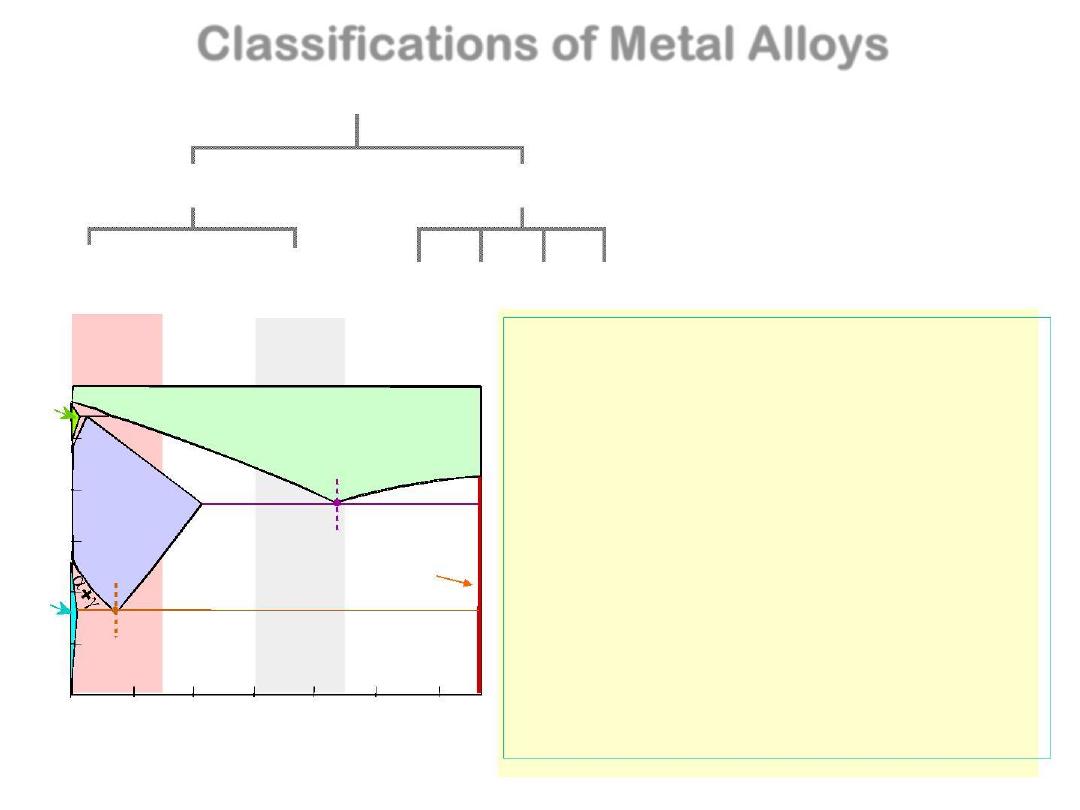
Classifications of Metal Alloys
Metal Alloys
Ferrous
Nonferrous
Steels
Steels
1
<1.4wt%C
.4wt%C
C
Cast
ast
Irons
Irons
3-4.5wt%C
Cu Al Mg Ti
Some definitions:
<
3-4.5tic
•
•
Ferrous alloys: iron is the prime constituent
Ferrous alloys are relatively inexpensive and
extremely versatile
T(
°C)
1600
d
L
• Thus these alloys are wide spread engineering
1400
g+L
materials
Alloys that are so brittle that forming by
deformation is not possible ordinary are cast
g
1200
1000
L+Fe C
3
4.30
Eutectic
1148
°C
•
austenite
Fe C
3
cementite
• Alloys that are amenable to mechanical
deformation are termed wrought
g+Fe C
3
a
800
727
°C
ferrite
0.77
Eutectoid
a
+Fe C
3
• Heat-treatable - are alloys whose mechanical
6 00
strength can be improved by heat-treatment
4 000
(Fe)
(e.g. precipitation hardening or martensitic
transformations).
1
2
3
4
5
6
6.7
Carbon concentration, wt.% C
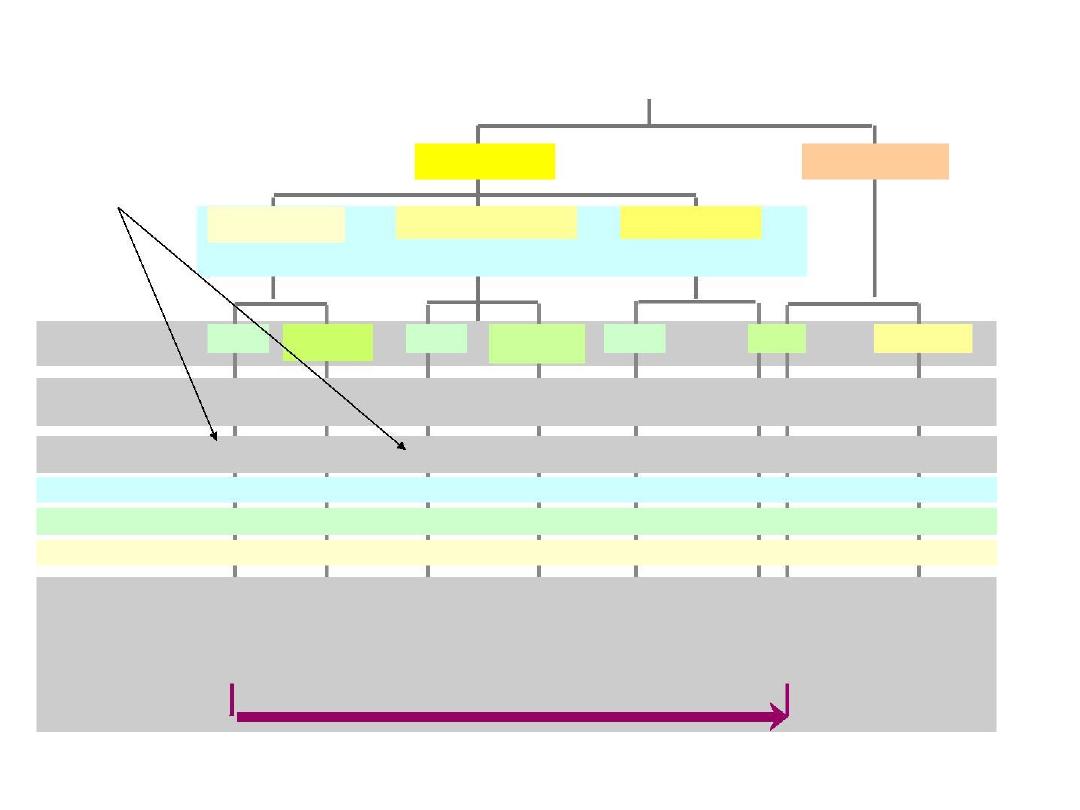
Classification of Steels
10-plane
or 0.4 C wt.%
Low Alloy
High Alloy
0.1
Medium-carbon High carbon
Low carbon
<0.25wt%C
0.25-0.6wt%C
0.6-1.4wt%C
High
Heat
Name:
Plain strength
Plain
Plain
Tool
Stainless
treatable
Additions:
noneCu,V,Ni,Mo none Cr, Ni,Mo none
Cr, V,Mo,W
Cr, Ni, Mo
Example
(ASTM#):1010
A633
1040
4340
1095
4190
304
Hardenability
TS
0
-
+
0
+
+
++
++
++
+
+++
++
0
0
EL
+
+
0
-
-
--
++
wear
applications
high T
applications
turbines
furnaces
corrosion
resistant
Applications:
auto
struc. towers
sheet press.
bridges crank
shafts
bolts
pistons
gears
wear
drills
saws
dies
vessels hammers applications
blades
increasing strength, cost, decreasing ductility
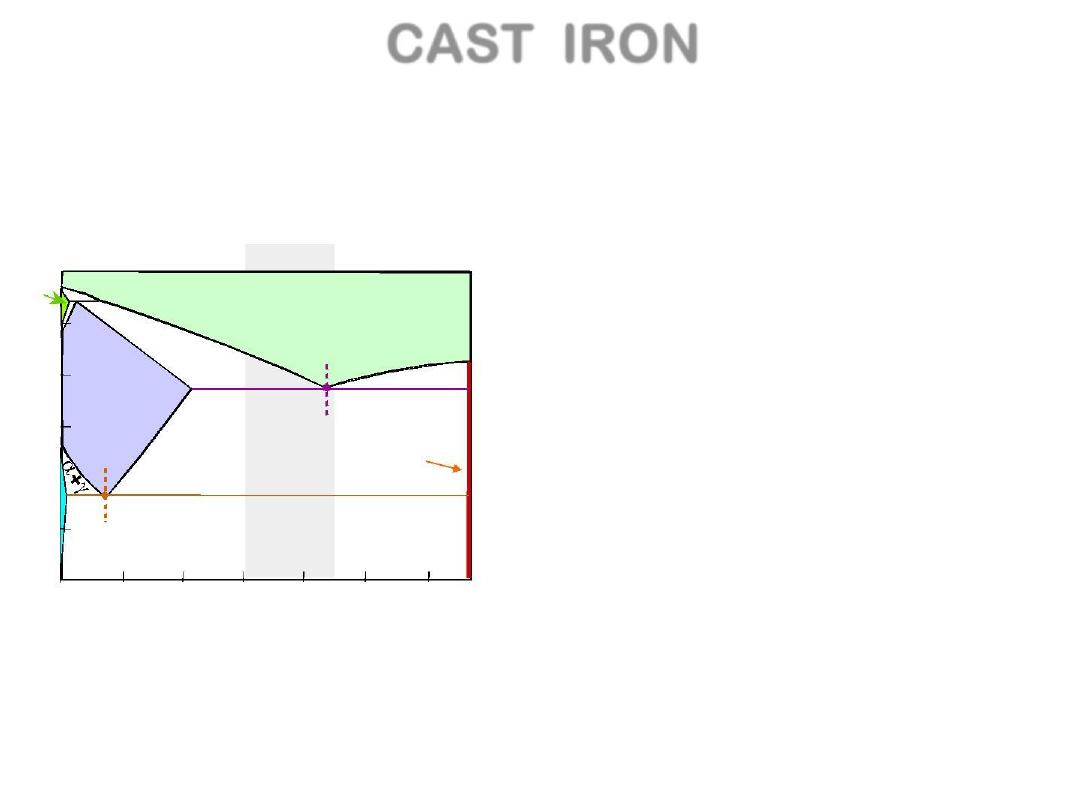
CAST IRON
• The cast irons are the ferrous alloys with greater that 2.14 wt. % carbon, but
typically contain 3-4.5 wt. % of C as well as other alloying elements, such as
silicon (~3 wt..%) which controls kinetics of carbide formation
3-4.5wt%C
3-4.5wt%C
•
(1150-1300
°C),
These alloys have relatively low melting points
do not formed undesirable surface
T(
°C)
1600
d
films when poured, and undergo moderate shrinkage
during solidification. Thus can be easily melted and
amenable to casting
L
1400
g+L
g
1200
1000
L+Fe C
3
1148
°C
austenite
•
There are four general types of cast irons:
4.30
Eutectic
1.
cementite
fracture surface. Large amount of Fe C are formed
during casting, giving hard brittle material
White iron has a characteristics white, crystalline
Fe C
3
g+Fe C
3
727
°C
3
0.77
Eutectoid
a
+Fe C
3
6 00
Carbon concentration, wt.% C
2. Gray iron has a gray fracture surface with finely
4000
(Fe)
faced structure. A large Si content (2-3 wt. %)
1
2
3
4
5
6
6.7
promotes C flakes precipitation rather than carbide
Ductile iron: small addition (0.05 wt..%) of Mg to gray iron changes the flake C
microstructure to spheroidal that increases (by factor ~20) steel ductility
Malleable iron: traditional form of cast iron with reasonable ductility. First cast to
white iron and then heat-treated to produce nodular graphite precipitates.
3.
4.
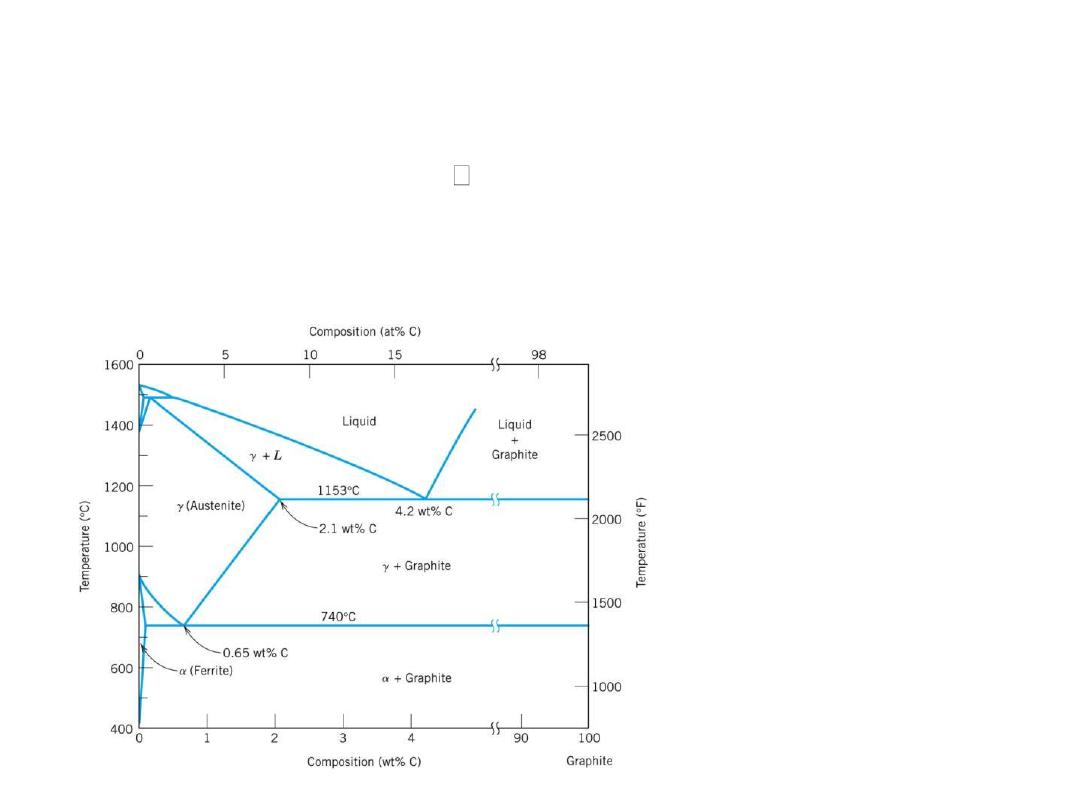
Equilibrium and Metastable Phases
• Cementite (Fe C) is a metastable phase and after long term treatment
decompose to form a-ferrite and carbon:
3
Fe3C 3Fe(S) + C(graphite)
•
•
Slow cooling and addition of some elements (e.g. Si) promote graphite formation
Properties of cast irons are defined by the amount and microstructure of
existing carbon phase.
•Equilibrium iron-carbon
phase diagram
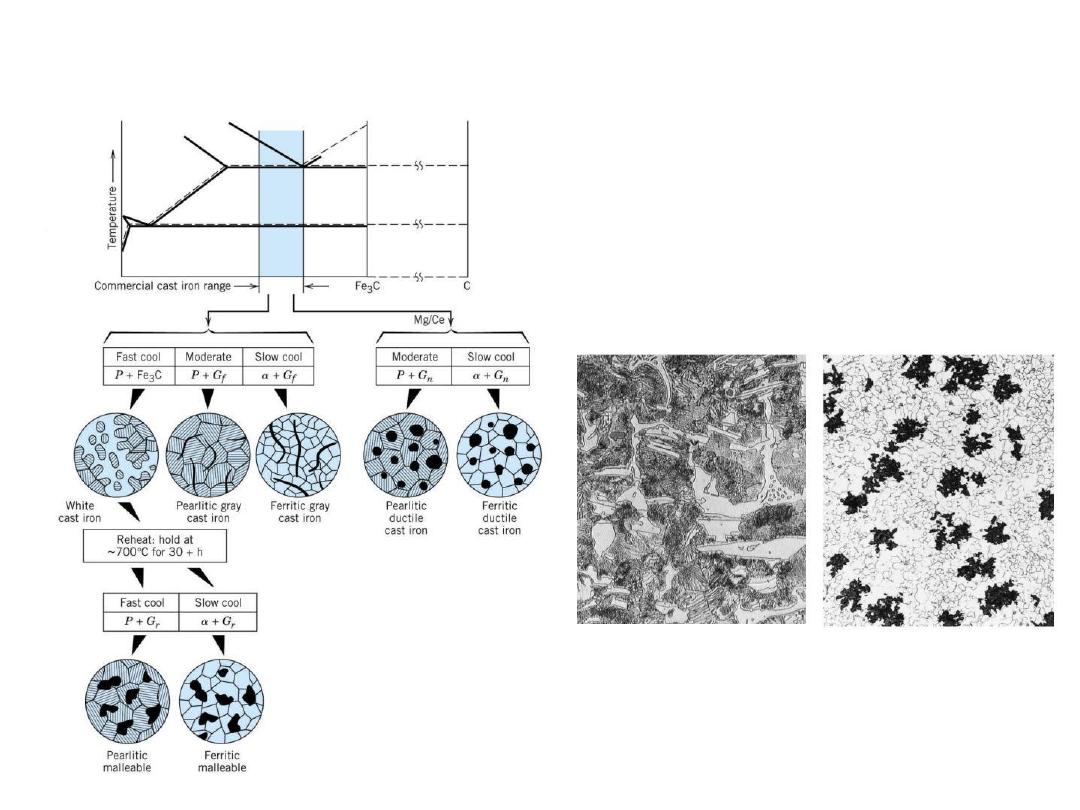
White and Malleable Cast Irons
• The low-silicon cast irons (<1.0wt.%),
produced under rapid cooling conditions
•
•
•
Microstructure: most of cementite
Properties: extremely hard very but brittle
White iron is an intermediate for the
production of malleable iron
White iron:
Malleable iron:
light Fe C regions dark graphite rosettes
3
surrounded
by pearlite
in a-Fe matrix
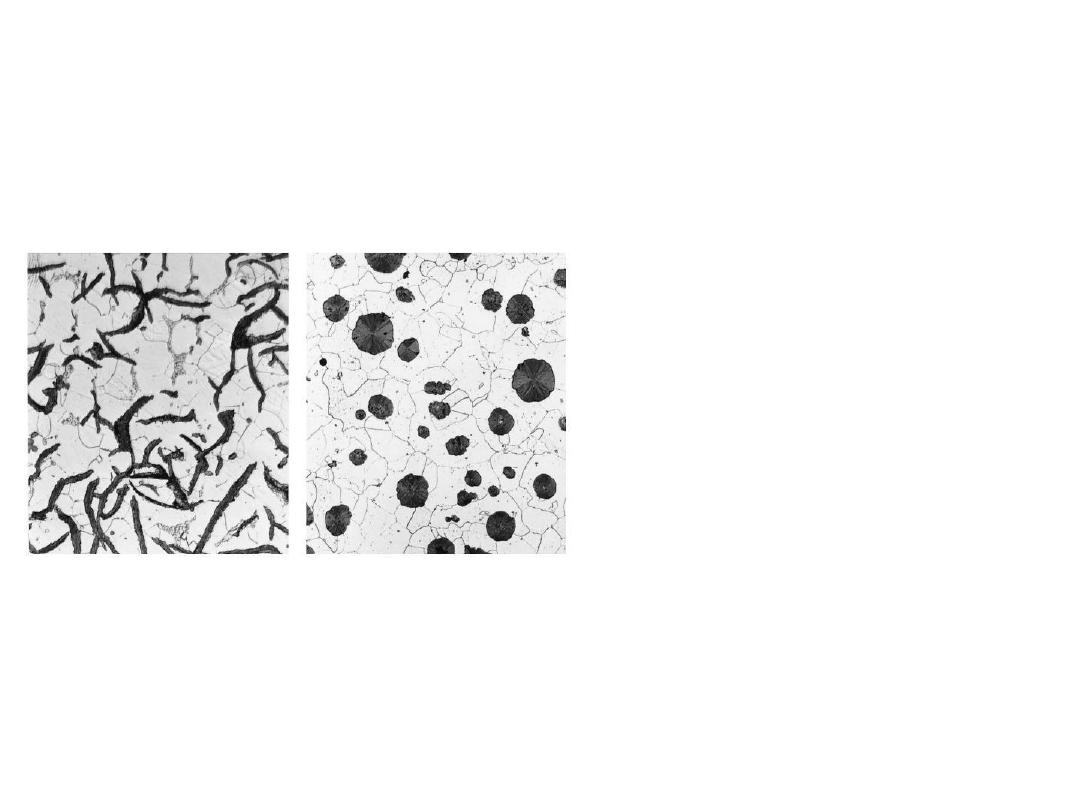
Gray and Ductile Cast Irons
The gray irons contain 1-31.0 wt..% of Si
•
•
•
Microstructure: flake
–shape graphite in ferrite matrix
Properties: relatively weak and brittle in tension BUT very effective in damping
vibrational energy an high resistive to wear!!
•Ductile (or Nodular) iron :
small addition of Mg or/and Ce to the
gray iron composition before casting
•
Microstructure: Nodular or spherical-like
graphite structure in pearlite or ferric matrix
Properties: Significant increase in material
ductility !!
Applications: valves, pump bodies, gears
and other auto and machine components.
•
•
Gray iron:
Dark graphite flakes
In a-Fe matrix
Ductile iron:
dark graphite nodules
in a-Fe matrix
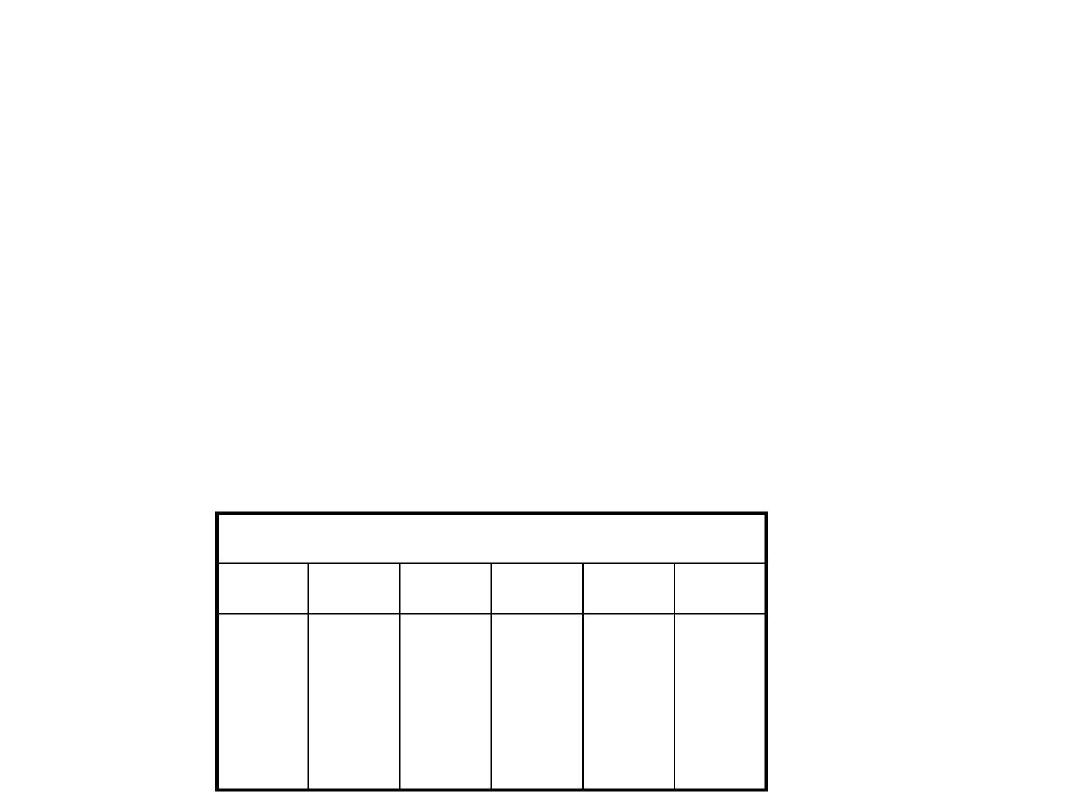
RAPIDLY SOLIDIFIED FERROUS ALLOYS
• Eutectic compositions that permit cooling to a glass transition
temperature at practically reachable quench rate (10
5
and 10
6
C
°/s) –
- rapidly solidified alloys
•
•
Boron, B, rather than carbon is a primary alloying element for
amorphous ferrous alloys
Properties:
(a) absence of grain boundaries
– easy magnetized materials
(b) extremely fine structure
– exceptional strength and toughness
Compositions (wt. %)
•Some Amorphous
Ferrous Alloys
B
Si
Cr
Ni Mo
P
20
10
28
6
10
6
6
40
14
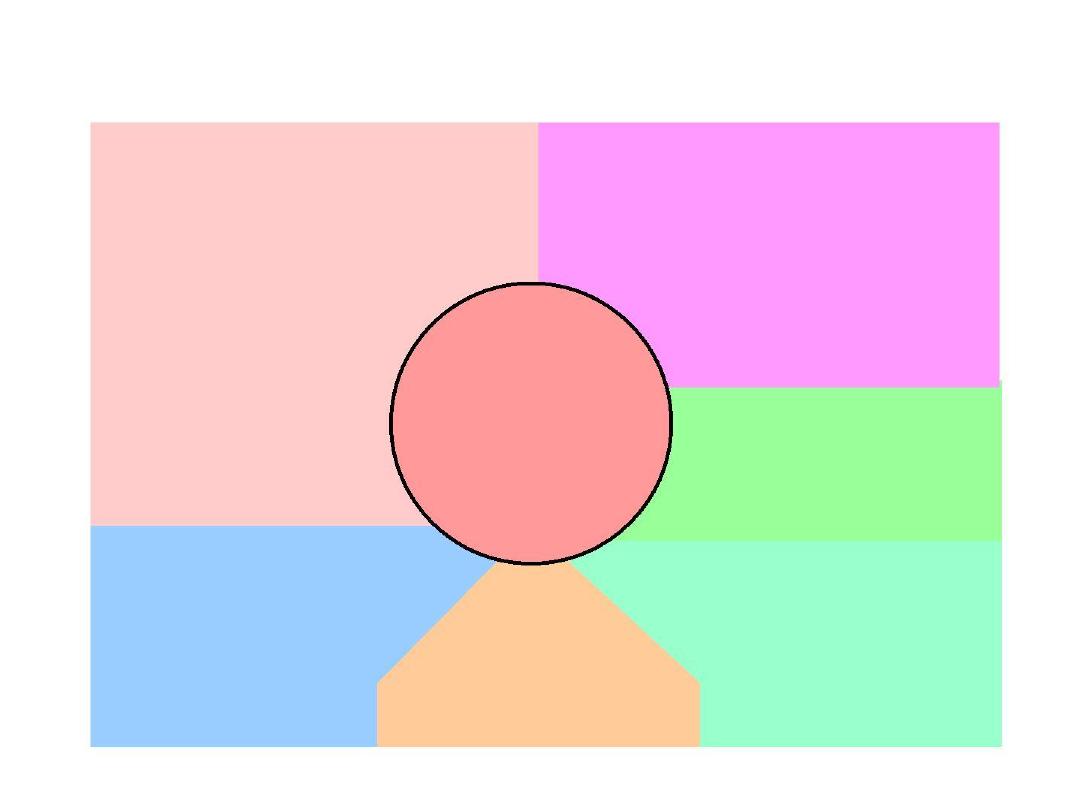
NONFERROUS ALLOYS
• Cu Alloys
• Al Alloys
Brass
: Zn is prime impurity
(costume jewelry, coins,
corrosion resistant)
r: 2.7g/cm
3
-lower
-Cu, Mg, Si, Mn, Zn additions
-solid solutions or precipitation
strengthened (structural
aircraft parts
Bronze
: Sn, Al, Si, Ni are
prime impurities
(bushings, landing gear)
& packaging)
Nonferrous
• Mg Alloys
Cu-Be
precipitation-hardened
-very low r: 1.7g/cm
3
-ignites easily
Alloys
for strength
- aircraft, missiles
• Ti Alloys
• Refractory metals
-lower r: 4.5g/cm
3
vs 7.9 for steel
• Noble metals
-high melting T
-Nb, Mo, W, Ta
-reactive at high T
-Ag, Au, Pt
-space applications
- oxidation/corrosion
resistant
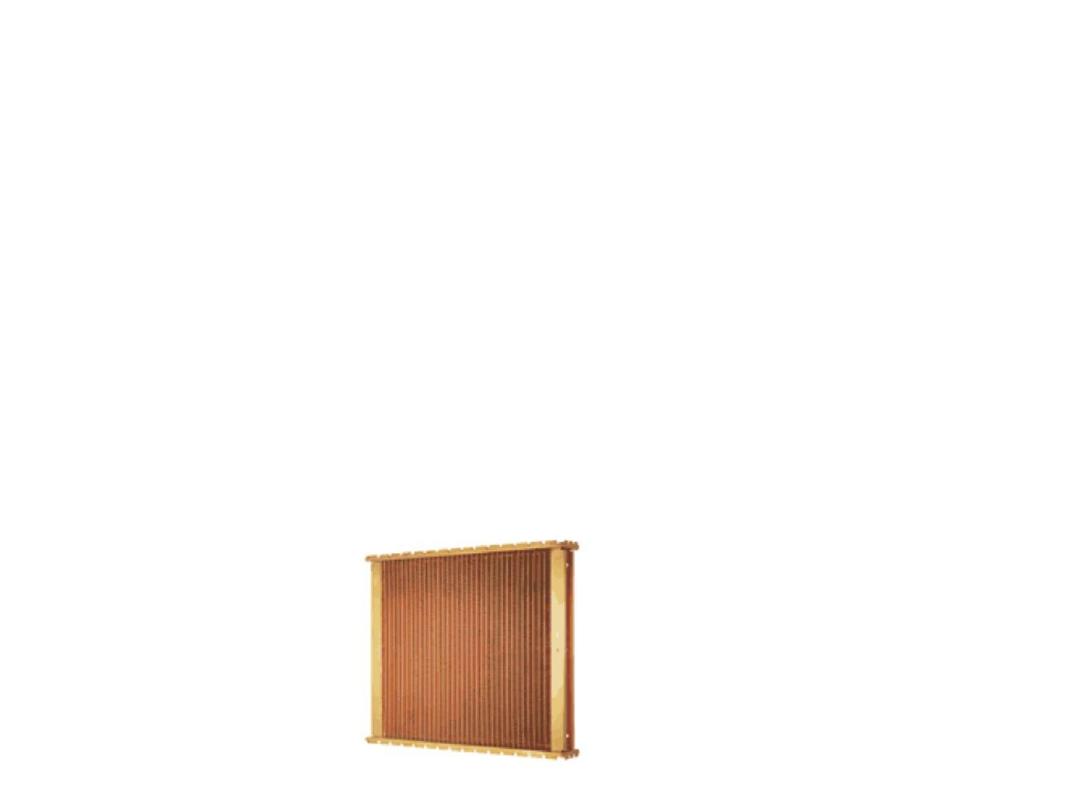
Cooper and its Alloys
• Cooper: soft and ductile; unlimited cold-work capacity, but difficult to
machine.
•
•
Cold-working and solid solution alloying
Main types of Copper Alloys:
–
–
–
Brasses: zinc (Zn) is main substitutional impurity; applications: cartridges,
auto-radiator. Musical instruments, coins
Bronzes: tin (Sn), aluminum (Al), Silicon (Si) and nickel (Ni); stronger
than brasses with high degree of corrosion resistance
Heat-treated (precipitation hardening) Cu-alloys: beryllium coopers;
relatively high strength, excellent electrical and corrosion properties BUT
expensive; applications: jet aircraft landing gear bearing, surgical and
dental instruments.
•
Copper
’s advantages as primary
metal and recycled metal, for brazed,
long-life radiators and radiator parts
for cars and trucks:
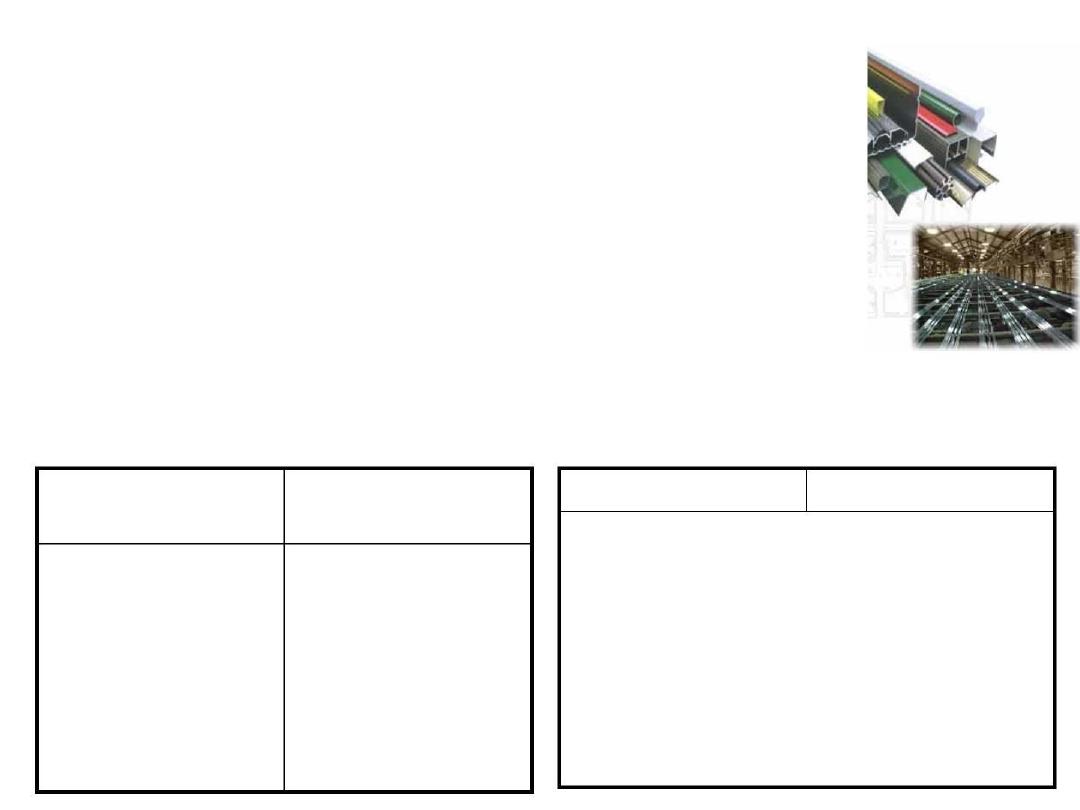
Aluminum and its Alloys
•
•
Low density (~2.7 g/cm ), high ductility (even at room temperature),
3
high electrical and thermal conductivity and resistance to corrosion
BUT law melting point (~660
°C)
Main types of Aluminum Alloys:
-
-
-
Wrought Alloys
Cast Alloys
Others: e.g. Aluminum-Lithium Alloys
• Applications: form food/chemical handling to aircraft structural parts
Typical alloying elements and alloy
Temper designation systems for
designation systems for Aluminum Alloys
Aluminum Alloys
Numerals
Major Alloying
Element(s)
Temper
Definition
F
As fabricated
Annealed
O
1XXX
2XXX
3XXX
4XXX
5XXX
6XXX
7XXX
8XXX
None (>99.00 %Al)
H1
H2
H3
T1
T2
T3
T4
T5
T6
T7
T8
T9
Strain-hardened only
Strain-hardened and partially annealed
Strain-hardened and stabilized
Cu
Cooled from elevated-T shaping and aged
Cooled from elevated-T shaping, cold-work, aged
Solution heat-treat., cold-work, naturally aged
Solution heat-treat and naturally aged
Mn
Si
Mg
Cooled from elevated-T shaping, artificially aged
Solution heat-treat. and artificially aged
Solution heat-treat and stabilized
Mg an Si
Zn
Solution heat-treat, cold-work, artificially aged
Solution heat-treat, artificially aged, cold-work
Other elements (e.g. Li)
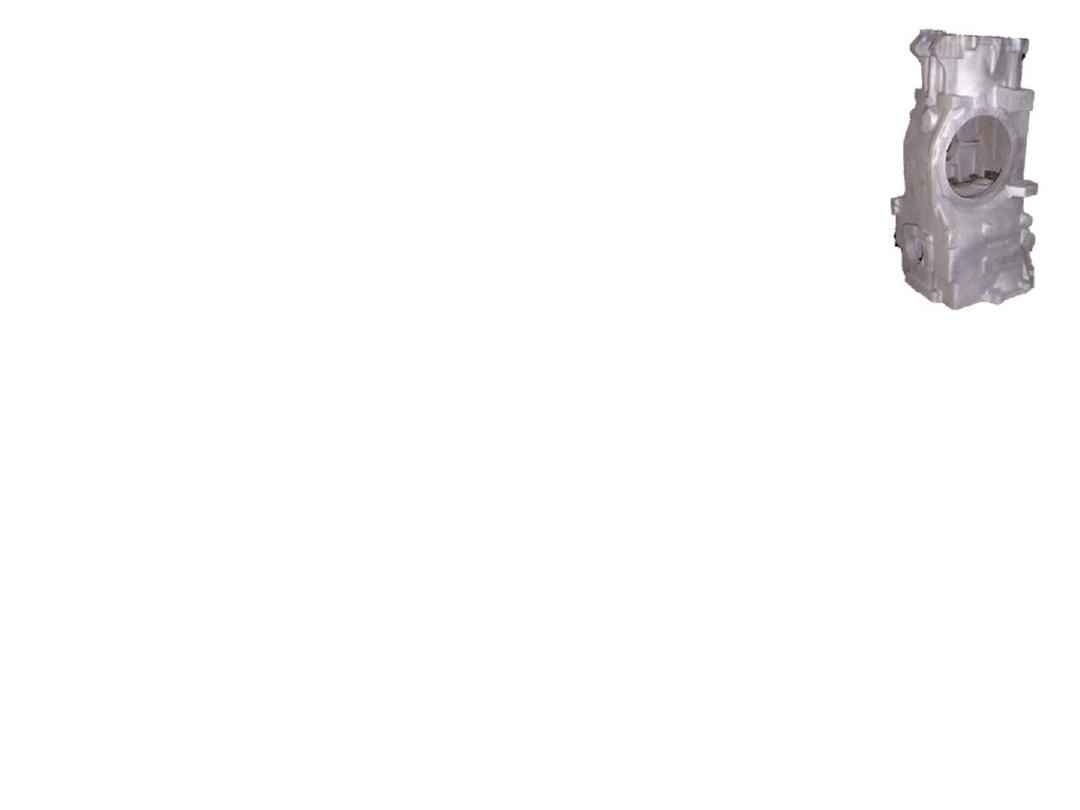
Magnesium and its Alloys
Formula 1
Gearbox Casting
• Key Properties:
• Light weight
·
·
·
Low density (1.74 g/cm two thirds that of aluminium)
3
Good high temperature mechanical properties
Good to excellent corrosion resistance
•
•
Very high strength-to density ratios (specific strength)
In contrast with Al alloys that have fcc structure with (12 ) slip systems and thus high
ductility, hcp structure of Mg with only three slip systems leads to its brittleness.
• Applications: from tennis rockets to aircraft and missiles
Example: Aerospace
RZ5 (Zn 3.5 - 5,0 SE 0.8 - 1,7 Zr 0.4 - 1,0 Mg remainder), MSR (AG 2.0 - 3,0 SE 1.8 -
2,5Zr 0.4 - 1,0 Mg remainder) alloys are widely used for aircraft engine and gearbox
casings. Very large magnesium castings can be made, such as intermediate compressor
casings for turbine engines. These include the Rolls Royce Tay casing in MSR, which
weighs 130kg and the BMW Rolls Royce BR710 casing in RZ5. Other aerospace
applications include auxiliary gearboxes (F16, Euro-fighter 2000, Tornado) in MSR or
RZ5, generator housings (A320 Airbus, Tornado and Concorde in MSR) and canopies,
generally in RZ5.

Titanium and its Alloys (1)
•
•
Titanium and its alloys have proven to be
technically superior and cost-effective materials of
construction for a wide variety of aerospace,
industrial, marine and commercial applications.
The properties and characteristics of titanium which
are important to design engineers in a broad
spectrum of industries are:
- Excellent Corrosion Resistance:
Titanium is
immune to corrosive attack by salt water or marine
atmospheres. It also exhibits exceptional resistance
to a broad range of acids, alkalis, natural waters and
industrial chemicals.
-
Superior Erosion Resistance:
Titanium offers
superior resistance to erosion, cavitation or
impingement attack. Titanium is at least twenty
times more erosion resistant than the copper-nickel
alloys.
-
High Heat Transfer Efficiency:
Under "in
service" conditions, the heat transfer properties of
titanium approximate those of admiralty brass and
copper-nickel.

Other Alloys
• The Refractory Metals: Nb (m.p.=2468
°C); Mo (°C); W (°C); Ta(3410°C)
-
-
Also: large elastic modulus, strength, hardness in wide range of temperatures
Applications:
• The Super alloys – possess the superlative combination of properties
-
-
Examples:
Applications: aircraft turbines; nuclear reactors, petrochemical equipment
• The Noble Metal Alloys:
Ru(44), Rh (45), Pd (46), Ag (47), Os (75), Ir (77), Pt (78), Au (79)
- expensive are notable in properties: soft, ductile, oxidation resistant
Applications: jewelry (Ag, Au, Pt), catalyst (Pt, Pd, Ru),
-
thermocouples (Pt, Ru), dental materials etc.
• Miscellaneous Nonferrous Alloys:
-
65Ni/28Cu/7wt%Fe
Nickel and its alloy: high corrosion resistant (Example: monel
–
– pumps valves in aggressive environment)
Lead, tin and their alloys: soft, low recrystallization temperature, corrosion
resistant (Applications: solders, x-ray shields, protecting coatings)
-
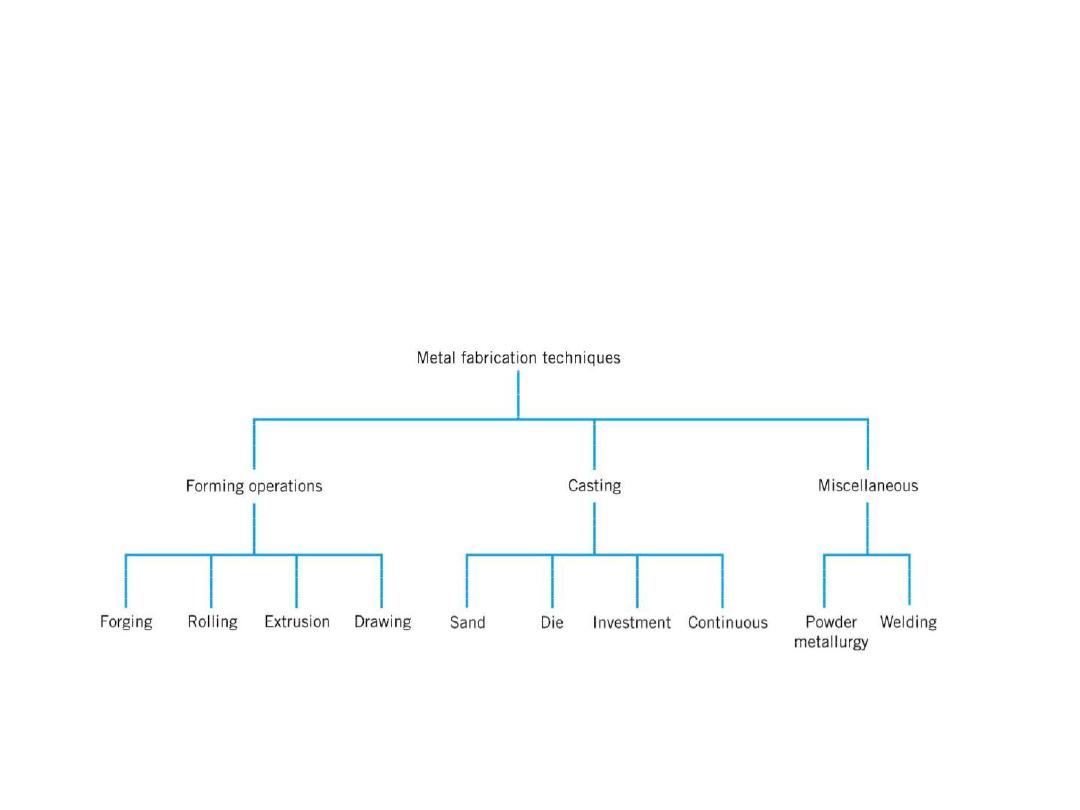
Fabrication of Metals
• Fabrication methods chosen depend on:
-
-
-
properties of metal
size and shape of final piece
cost
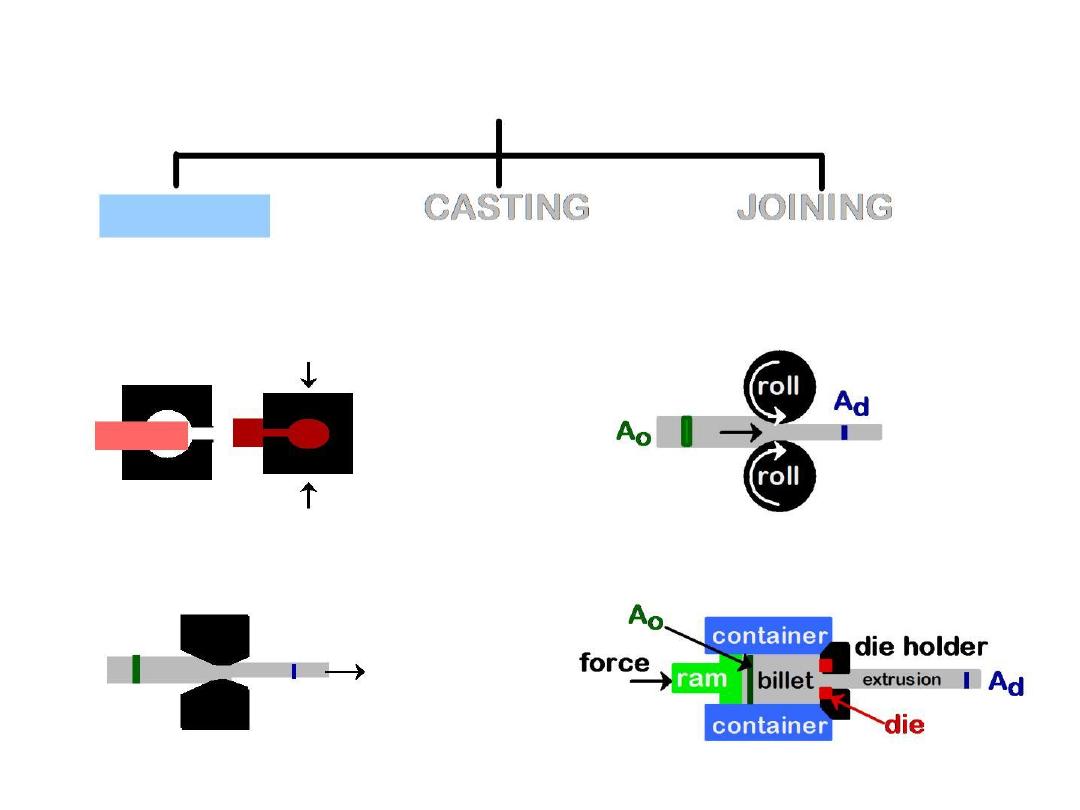
METAL FABRICATION METHODS-I
FORMING
•
Forging
(wrenches, crankshafts)
•
Rolling
(I-beams, rails)
force
die
A
blank
often at
Ad
elev. T
o
force
•
Drawing
•
Extrusion
(rods, wire, tubing)
(rods, tubing)
die
Ad
tensile
force
Ao
die
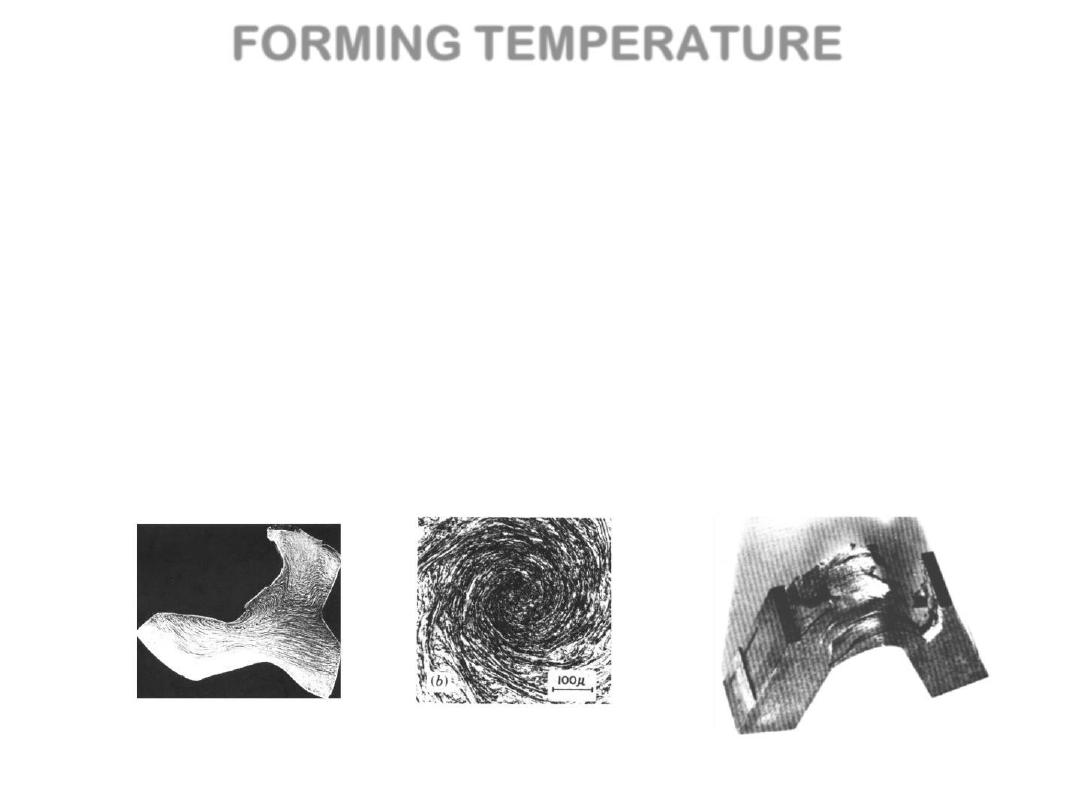
FORMING TEMPERATURE
•
Hot working: deformation
at T > T(recrystallization)
•
Cold working: deformation
at T < T (recrystallization)
+ higher quality surface
+ better mechanical properties
+ closer dimension control
+
+
-
less energy to deform
large repeatable deform.
surface oxidation: poor finish
- expensive and inconvenient
•
Cold worked microstructures
--generally are very
anisotropic!
--Forged
--Swaged
--Fracture resistant!

Extrusion and Rolling
•
•
The advantages of extrusion over rolling are as
follows:
- Pieces having more complicated cross-sectional
geometries may be formed.
- Seamless tubing may be produced.
The disadvantages of extrusion over rolling are as
follows:
- Nonuniform deformation over the cross-section.
- A variation in properties may result over the
cross-section of an extruded piece.
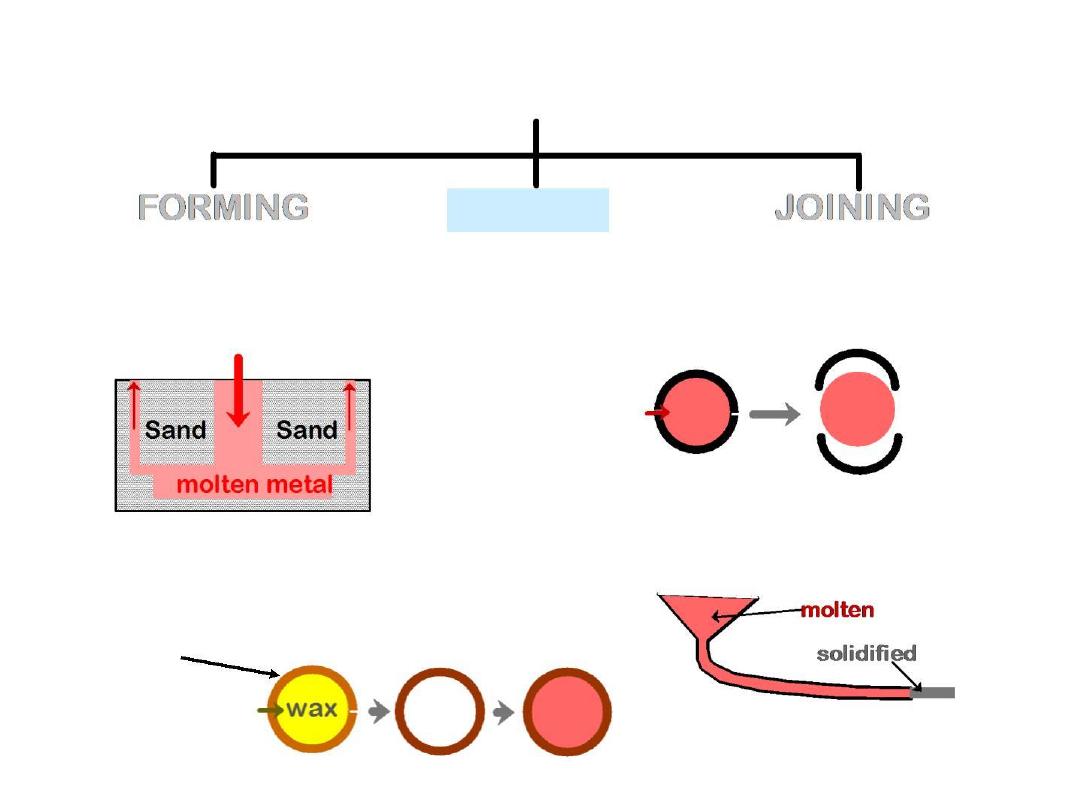
METAL FABRICATION METHODS-II
CASTING
•
Sand Casting
(large parts, e.g.,
auto engine blocks)
•
Die Casting
(high volume, low T alloys)
•
Continuous Casting
(simple slab shapes)
•
Investment Casting
(low volume, complex shapes
e.g., jewelry, turbine blades)
plaster
die formed
around wax
prototype

Casting
• The situations in which casting is the preferred fabrication technique are:
-
-
-
-
For large pieces and/or complicated shapes.
When mechanical strength is not an important consideration.
For alloys having low ductility.
When it is the most economical fabrication technique.
Different casting techniques:
Sand casting: a two-piece mold made of send is used, the surface finish is not an
important consideration, casting rates are low, and large pieces are usually cast.
Die casting: a permanent two-piece mold is used, casting rates are high, the molten
metal is forced into the mold under pressure, and small pieces are normally cast.
Investment casting: a single-piece mold is used, which is not reusable; it results in
•
•
•
high dimensional accuracy, good reproduction of detail, a fine surface finish; casting
rates are low.
• Continuous casting: at the conclusion of the extraction process, the molten metal
is cast into a continuous strand having either a rectangular or circular cross-section;
these shapes are desirable for secondary metal-forming operations. The chemical
composition and mechanical properties are uniform throughout the cross-section.
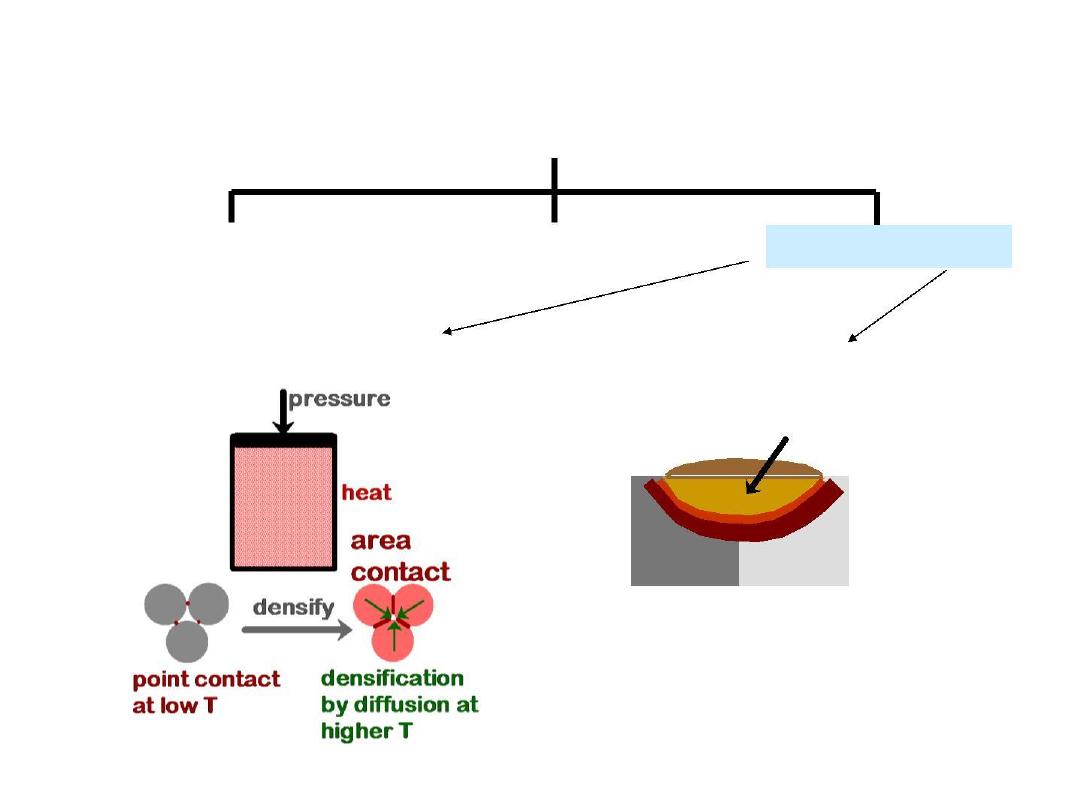
METAL FABRICATION METHODS-III
FORMING
CASTING
Miscellaneous
•
Powder Processing
•
Joining: Welding, brazing, soldering
filler metal (melted)
base metal (melted)
fused base metal
heat affected zone
unaffected
unaffected
piece 1
piece 2
•
Heat affected zone:
(region in which the
microstructure has been
changed).

Powder Processing
•
•
Some of the advantages of powder metallurgy over casting are as follows:
-
-
-
It is used for materials having high melting temperatures.
Better dimensional tolerances result.
Porosity may be introduced, the degree of which may be controlled (which is
desirable in some applications such as self-lubricating bearings).
Some of the disadvantages of powder metallurgy over casting are as follows:
-
-
Production of the powder is expensive.
Heat treatment after compaction is necessary.

Annealing
Process: heat alloy to T , for extended period of time then cool slowly.
Anneal
Goals: (1) relieve stresses; (2) increase ductility and toughness; (3) produce
specific microstructure
•
Spheroidize
(steels):
•
Stress Relief :
Make very soft steels
for good machining.
To reduce stress caused by:
-plastic deformation
-non-uniform cooling
-phase transform.
Heat just below T
E
& hold for 15-25h.
Types
of
•
Make soft steels for
Full Anneal
(steels):
Annealing
good forming by heating
to get , then cool in
• Process Anneal:
g
furnace to get coarse P.
To eliminate negate
e ffect of cold
working
by recovery/recrystallization
•
Normalize
(steels):
Deformed steel with large grains
heat-treated to make grains small.
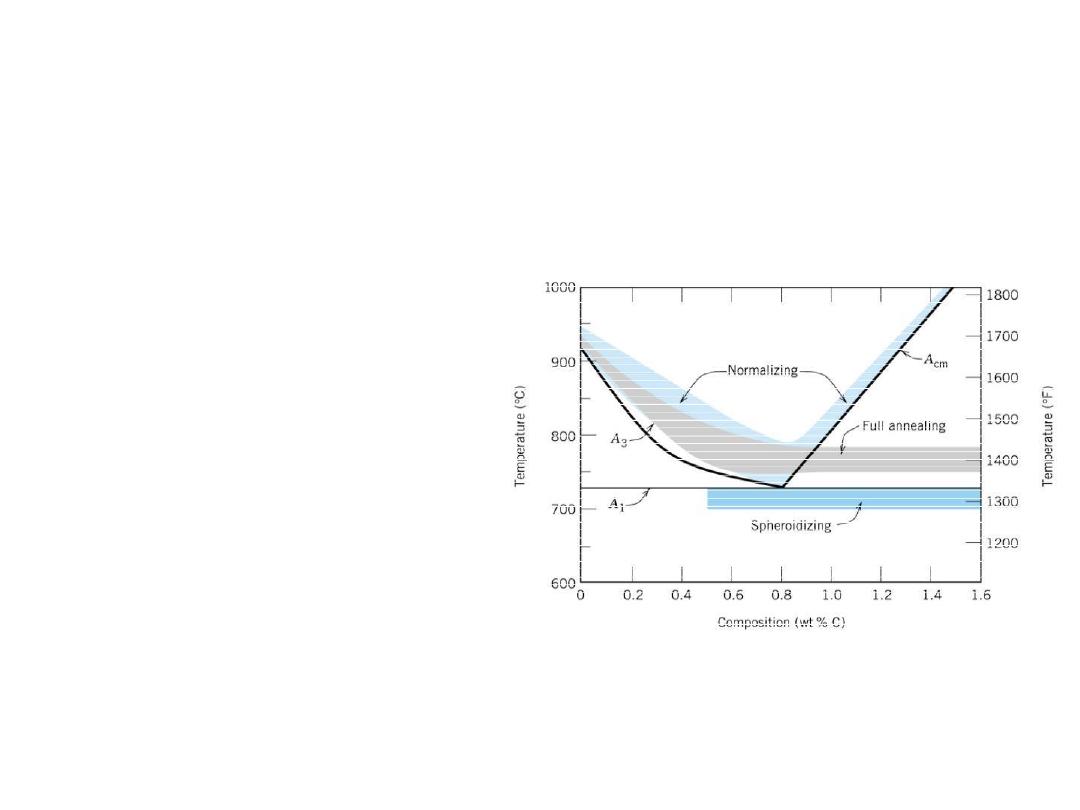
Thermal Processing of Metals: Steels
• Full annealing:
Heat to between 15 and 40
°C above the A3 line (if the concentration of carbon is less than the
eutectoid) or above the A1 line (if the concentration of carbon is greater than the eutectoid)
until the alloy comes to equilibrium; then furnace cool to room temperature.
The final microstructure is coarse pearlite.
•
Normalizing:
Heat to between 55 and 85
°C above the
upper critical temperature until the
specimen has fully transformed to
austenite, then cool in air. The final
microstructure is fine pearlite.
• Quenching:
Heat to a temperature within the austenite
phase region and allow the specimen to
fully austenite, then quench to room
temperature in oil or water. The final
microstructure is martensite.
• Tempering:
Heat a quenched (martensitic) specimen, to a temperature between 450 and 650
°C, for the time
necessary to achieve the desired hardness. The final microstructure is tempered martensite.
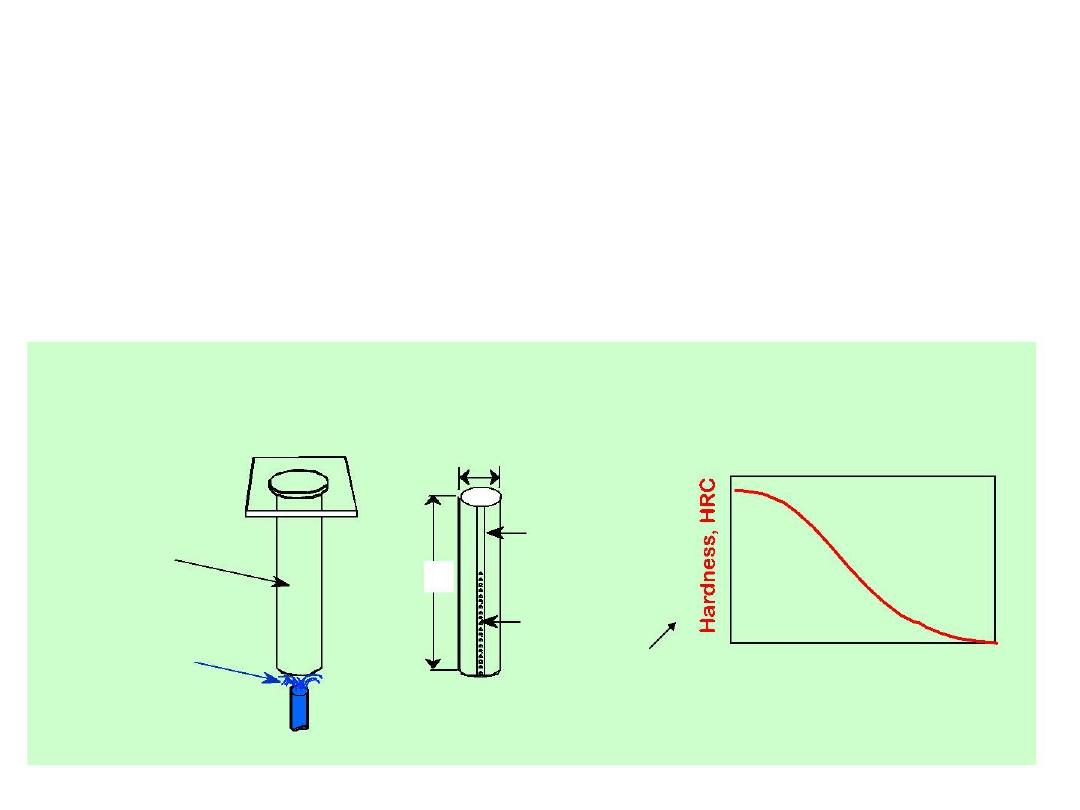
HARDENABILITY: STEELS
•
•
•
Full annealing and Spheroidizing: to produce softer steel for good
machining and forming
Normalization: to produce more uniform fine structure that tougher
than coarse-grained one
Quenching: to produce harder alloy by forming martensitic structure
Hardness versus
distance
from the quenched end
Jominy end-quenching test
1
”
flat ground
specimen
(heated to
4”
g-phase field)
Rockwell
Hardness test
Distance from
quenched end
24
°C water
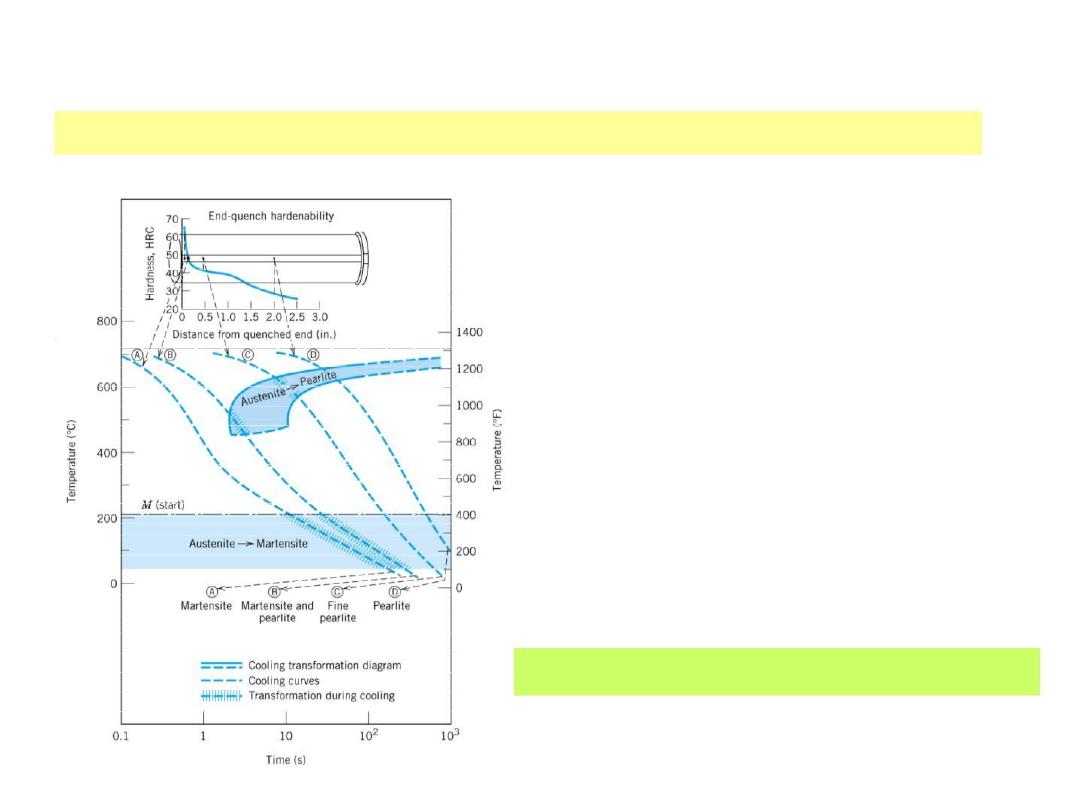
WHY HARDNESS CHANGES W/POSITION?
Because the cooling rate varies with position !!
• Note: cooling rates before reaching
Austenite
– Martensite transformation
are in the range 1 -50 C/s
• Measuring cooling rates at every point
(e.g. by thermocouples) and finding rates
correlations with the hardness one may
develop quenching rate
– hardness diagram
•But how one can change quenching rate?
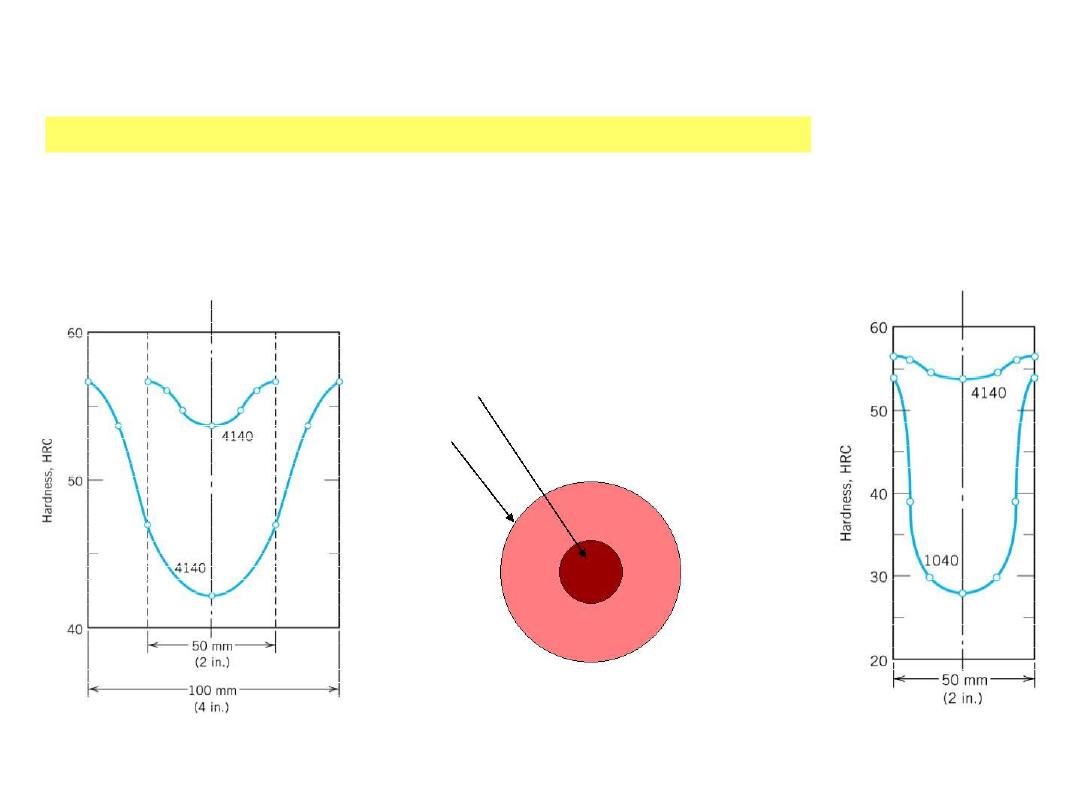
QUENCHING GEOMETRY
•
Effect of geometry:
When surface-to-volume ratio increases:
rate increases --cooling
--hardness increases
Position Cooling rate Hardness
center
surface
small
large
small
large
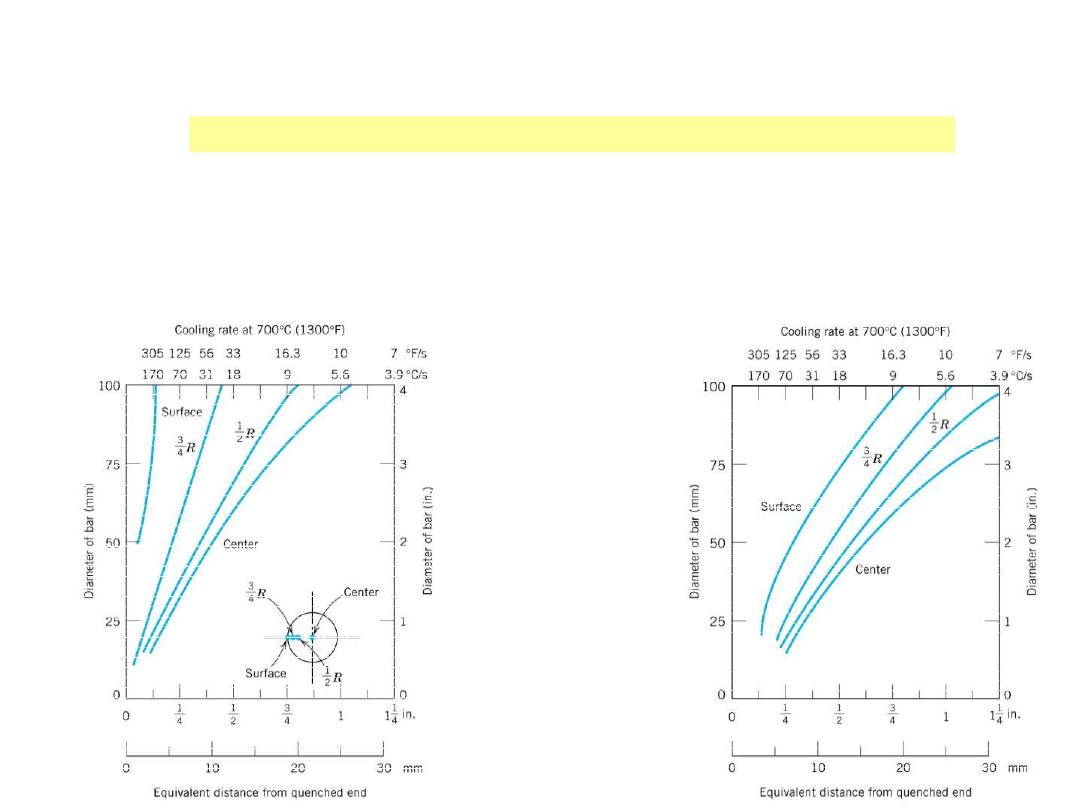
QUENCHING MEDIUM
• Effect of quenching medium:
Medium
air
oil
Severity of Quench
small
moderate
large
Hardness
small
moderate
large
water
Water
Oil
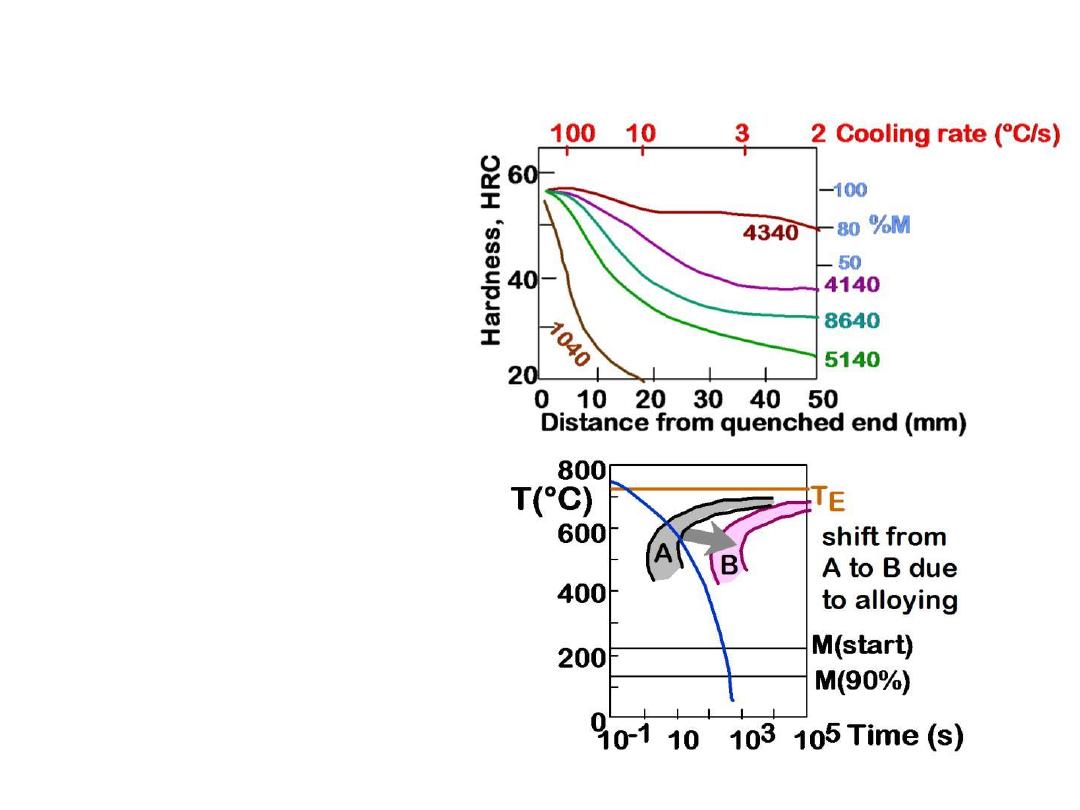
HARDENABILITY VS ALLOY CONTENT
•
•
Jominy end quench
results, C = 0.4wt%C
"Alloy Steels"
(4140, 4340, 5140, 8640)
--contain Ni, Cr, Mo
(0.2 to 2wt%)
--these
elements shift
the "nose".
--martensite is easier to form.
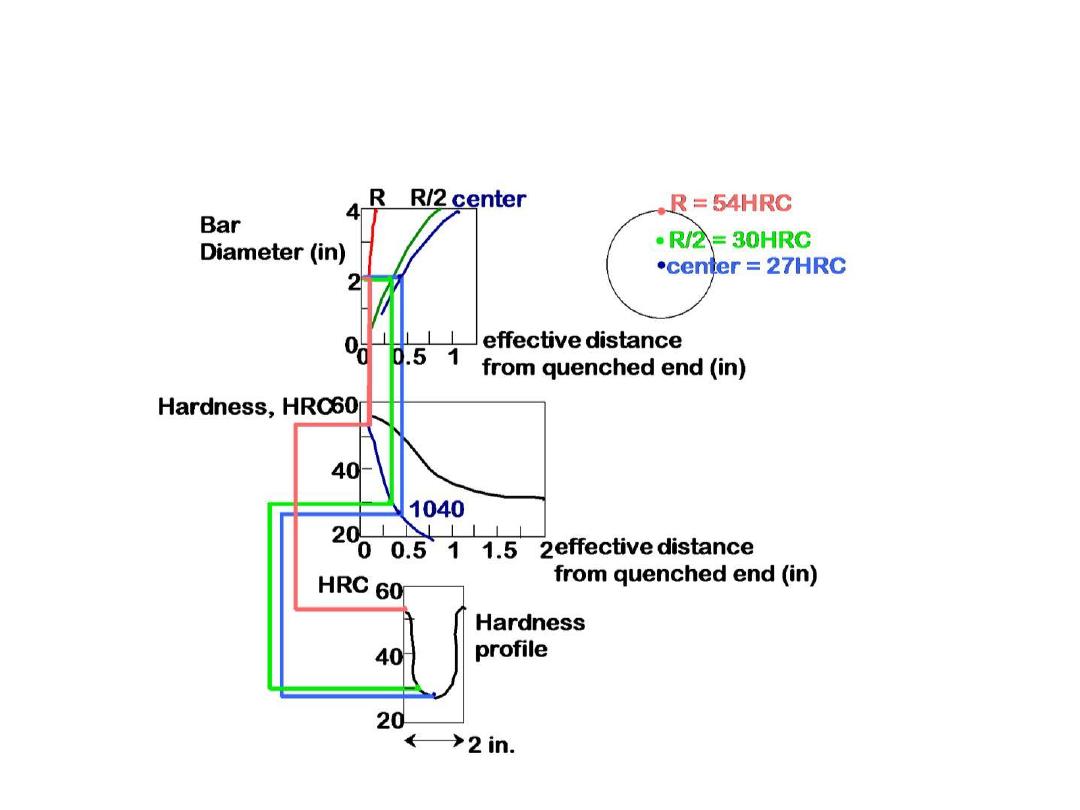
PREDICTING HARDNESS PROFILES
• Ex: Round bar, 1040 steel, water quenched, 2" diam.

SUMMARY
• Steels: increase TS, Hardness (and cost) by adding
--C (low alloy steels)
--Cr, V, Ni, Mo, W (high alloy steels)
--ductility usually decreases w/additions.
• Non -ferrous:
--Cu, Al, Ti, Mg, Refractory, and noble metals.
• Fabrication techniques:
--forming, casting, joining.
•
Hardenability
--increases with alloy content.
• Precipitation hardening
--effective means to increase strength in
Al, Cu, and Mg alloys.
